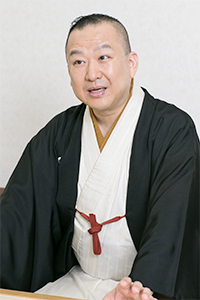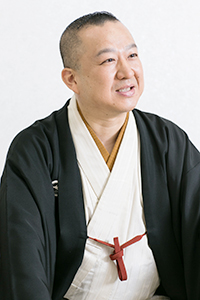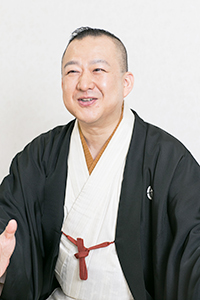- SOPHIA ONLINE Top
- Sophians Talk -Japan and the World
- Sannosuke Yanagiya

Attract More People to Live Performances Using the Internet as Gateway
- Sannosuke Yanagiya
- (Rakugo comic storyteller)
My First Impression Was “Can They Really Keep Going Like This?”

If I hadn't made it into Sophia University, I wouldn't now be a professional storyteller—probably not, anyway.
In high school my studies were motivated not so much by wanting to go to university as by an intense desire to move to Tokyo, but I was lucky enough to get a place in the Faculty of Economics on recommendation. At that time I was already secretly determined not to follow the path my parents wanted me to follow, though.
That being the case, I knew I would have to earn my own tuition fees, so I spent the next two years working part-time delivering newspapers in return for having my tuition subsidized by a newspaper company. The morning edition had to be delivered at dawn, the evening edition at 3 p.m., and it was five days a week, so obviously I couldn't take part in any university club activities, and going for a drink with everyone after class was out of the question. As a result, I diverged further and further from the path of true studenthood and increasingly stopped even going to the university. I wasn't exactly enjoying a fulfilling life on campus, I can tell you.
But Sophia did me a favor by accepting me as I was and leaving me to my own devices. That meant I could see lots of theater—I had done some acting as a high school student—as well as other shows and live performances of all kinds. One place I ended up going to was a variety show theater, and that was how I first encountered Rakugo. That was the time when the matinee performances in variety show theaters would feature more than twenty performers, even though there would be fewer than ten people in the audience. Initially it did spark my interest, but it was mainly because I was wondering how the entertainers and theaters could keep going with such small audiences (a typical Department of Management student!). Then for some reason my interest grew from there to storytelling as a profession, and eventually to Rakugo itself.
It was in the summer of my third year that I realized I wanted to become a professional storyteller. But I didn't want to just dive in armed with nothing except my passion for the art, so I decided to think about it carefully for another year. From that point I started to devote myself to doing my own research on the Rakugo world that I was intending to immerse myself in. I continued to have little to do with the actual classes at university, though: for one thing, I had replaced the newspaper delivery with another part-time job to earn my tuition, and that was keeping me busy.
But, as you might expect, Sophia was tolerant of someone like me who didn't fit the mold. It was thanks to that tolerance that a year later I was absolutely sure about what I wanted, and in early September I decided to take an apprenticeship under an established storyteller. Saying that, it sounds like everything just worked out without any hitches, but it didn't, you know. My tally of missed course credits had accumulated to the point where by the end of my fourth year I had 42 credits-worth of exams to take and couldn't afford to fail a single one. I had cut it really fine and got myself into a real predicament, and I realized that things were not as easy as I had thought. In February I started life as an apprentice, so I didn't even go to my own graduation ceremony. In fact, I wonder if I ever actually graduated—well, it must have happened somehow or other because I didn't get an invoice for tuition fees when the new academic year started.
The Good Thing Is There's No Ending

I had done the rounds of so many variety show theaters and Rakugo performances that there was no professional storyteller whose name and face I didn't know, and there were of course plenty that I liked. But there was only one master who—because of his personality as much as his performances—made me feel not just that I wanted to be his apprentice, but that I wanted to spend time around him, and that was Kosanji Yanagiya. I did my research and knew that he would at first deny my request to take me as an apprentice, saying something like “You won't make a living from it; don't bother.” So, resigning myself to staging a sit-in outside his door if necessary, I steeled myself to go as far as to say, “If you turn me down it's a waste of time, so why don't you just hurry up and say yes?” Maybe I was just pushy enough, or perhaps it was fate, or just an impulse on the master's part, but as it turned out, he simply agreed to take me as an apprentice straight away.
It goes without saying that a professional storyteller's apprenticeship involves physical labor—doing jobs for the master and other apprentices who have been there longer—as is the usual practice in Japan. But on top of that, the master was, as you might expect, really strict about use of language, so I became increasingly scared of actually saying anything to him. If I replied to something he said with “Yes, I understand,” he would get angry, and criticize me for wasting words. “If you can't make the single word ‘yes' also convey the sense of ‘I understand,' you're never going to able to tell stories,” he would say. And another thing that was really tough was having to do everything in my power to get rid of my deeply ingrained accent from the place where I grew up, and replace it with an old-fashioned Tokyo, or Edo, accent. But then, it's only to be expected, really. You see, Rakugo is essentially conversation: it's a form of entertainment made from dialogue itself.
It seems to me that these days people expect too much drama, even in Rakugo. That's why, when it comes to the final, headline act at a variety show theater, people tend not to be satisfied unless they get something that “rewards” them for listening, like a sentimental story with a happy ending. Yet in most of the classic Rakugo stories nothing actually happens; they are simply funny conversations that flow by with no particular conclusion or ending. And I think that lack of a conclusion is probably something all Japan's traditional forms of literature and entertainment have in common.
It was doubtless the influence of the Western world that made people start going on about endings, and even the “introduction, development, turn, and conclusion” compositional structure so well known in Japan is an approach that originated in classical Chinese poetry. Performances of traditional Japanese arts, on the other hand, generally follow the “introduction, development, and climax” structure, so they tend to end abruptly in full flow, leaving the audience surprised that it is suddenly finished. In fact, quite a lot of Noh and Kabuki plays also end in full flow like that. Storytelling may have no introduction, no middle section, and nothing else in terms of structure, but I would like people to enjoy this conversation-based entertainment and appreciate the spontaneity of the people long ago who refrained from imposing a structure where none was needed.
Rakugo Entertains in New Ways, Yet Stays the Same

People often say that in the world of Rakugo I'm a kind of trailblazer in terms of the Internet and social media, but in fact that's also thanks to Sophia. I was able to shut myself up in the university's computer room playing around with the earliest version of Windows, and that allowed me to experience this phenomenon called “surfing the net” for the first time. That led to me doing IT-related part-time work in the latter half of my time as a student, and subsequently to my current online activities.
Despite that, though, I'm not thinking of anything so outrageous as suggesting people should start watching Rakugo via digital media. Rakugo is only Rakugo if you watch it live. In making use of online video transmission and other digital media, my only aim is to give people a reason to go to variety show theaters or Rakugo performances. What is important, though, is the low-profile analogue work such as writing genuine replies to every single one of the e-mails and messages I receive. It's the same thing Rakugo storytellers have always done; it's just that the tools are different now.
But, having said that, the dramatic changes happening in media and society in general are also leading to changes in the nature of entertainment itself. Within this context, classic Rakugo is actually quite remarkable as a traditional performing art because, despite being referred to as “classic,” it is constantly being superseded by new versions. After all, you don't get any praise for performing an act exactly the way your master taught it to you. And that means there are as many different ways of performing acts as there are professional storytellers.
Nonetheless, Rakugo has a kind of spirit or core that must be preserved, and I think it is our job as professional storytellers to try to capture the unchanging capacity to entertain rooted in this spirit. Of course, we sometimes include up-to-date comic material as gags in our Rakugo, but they are never any more than an “added extra.” In fact, one of the joys of being a professional storyteller is to watch audience members who once laughed at Rakugo full of these gags, as they increasingly find them an unwelcome interruption, and want to enjoy their Rakugo unadulterated. Each professional storyteller uses his or her own judgment when it comes to including gags, so you can just compare styles and choose the ones you like.
In any case, I urge you to drop any prejudices you may have about Rakugo and just go to see it performed live, whether at a variety show theater, or a Rakugo performance, or wherever. If you just come, it doesn't matter if you're young or old, male or female, a first-timer or a regular, we will give everything we've got to making it worth your while. Because that's the kind of professionals we are.

- Sannosuke Yanagiya
- Rakugo comic storyteller
Graduated from Department of Management, Faculty of Economics in 1996.
Sannosuke Yanagiya was born in Tokyo in 1973. While a student at Sophia he took an apprenticeship to Kosanji Yanagiya the 10th. In 1996 he entered the Suzumoto Engeijo theater as a junior performer and subsequently trained in variety show theaters throughout Tokyo. In 1999, on his promotion to the second rank, he changed his name to Sannosuke Yanagiya, and in 2010 was promoted to star performer. He aims not only to promote himself, but to win over more Rakugo fans using new media in the form of the Internet. He started his own one-man-show, Have You Ever Seen a Sannosuke?, in 2004, which he performs in Sapporo and elsewhere across Japan. He also performs overseas.





